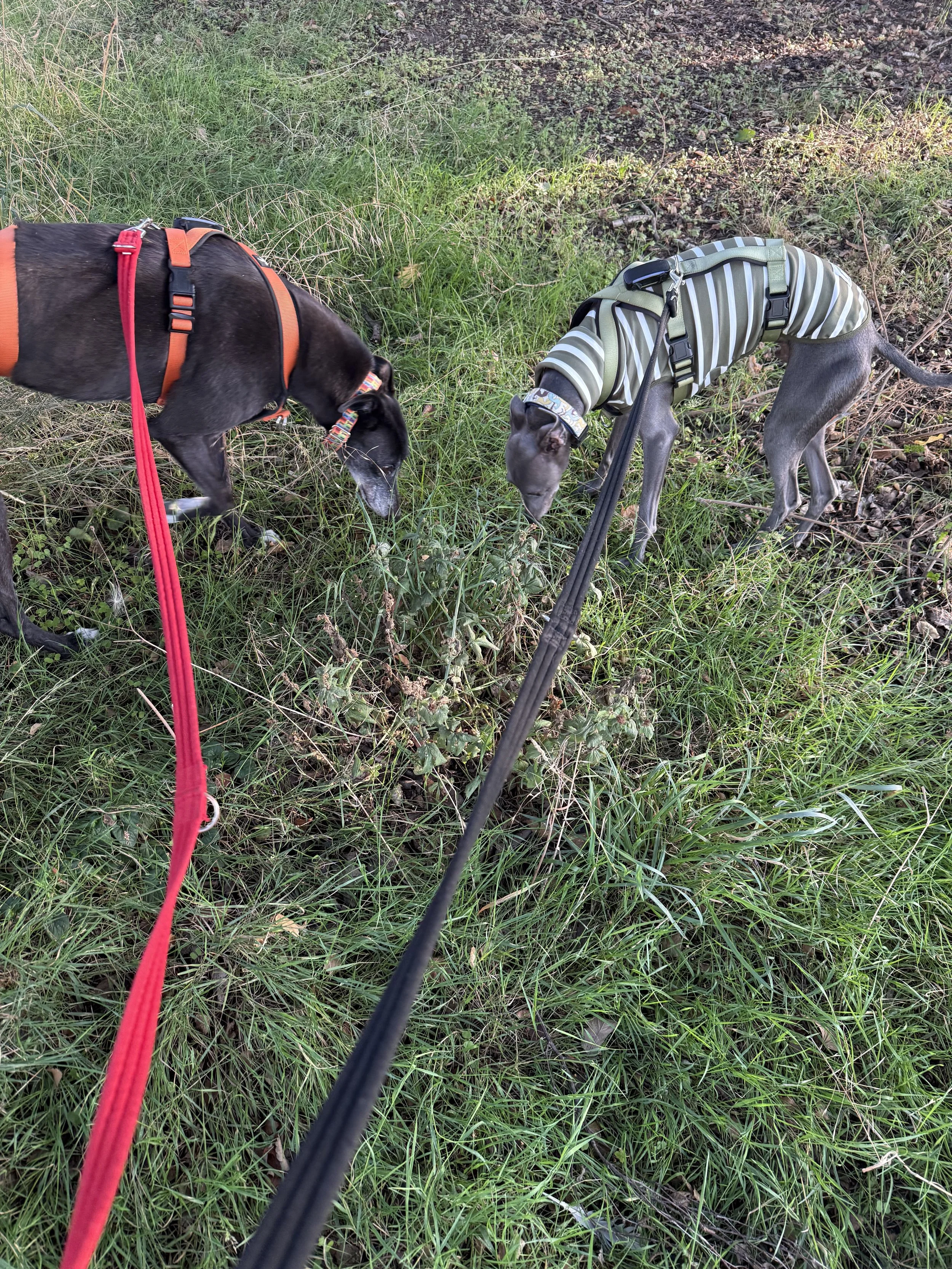The Nose Knows
When we think of sighthounds – greyhounds, whippets, salukis, lurchers – the clue feels like it’s in the name. They’re bred to hunt by sight, reacting in an instant to movement. But spend time with them and you soon realise: their noses are just as important.
Izzy, our ex-racing greyhound, and Freddie, our rescue whippet, both love a good sniff when we’re out walking. Watching them reminds me daily just how powerful a sighthound’s nose really is.
Why the nose matters (even for sighthounds)
Dogs live in a world of scent we humans can barely imagine. That quick sniff at a lamppost isn’t just “dog gossip” – it’s a full biography. From one sniff they can tell if the dog who left it was male or female, healthy or unwell, stressed or relaxed. They can follow the fading trail of wildlife long after it’s out of sight, or track the ghost of a scent left hours – even days – earlier. They can even pick up changes in our own scent when we’re tired, anxious, or happy.
Medical detection dogs are an impressive example of this skill in action – but even your own sighthound snoozing on the sofa can detect more than you’d ever realise.
Here are a few nose facts that always make me stop and appreciate just how incredible they are:
Super-scenting power – Dogs can have up to 300 million scent receptors compared to our six million. The part of their brain that interprets smells is about 40 times bigger (proportionally) than ours.
Built for sniffing – Their noses are cleverly designed to separate breathing from smelling. They can even breathe in and out at the same time when sniffing, creating a continuous flow of air – unlike us humans, who can only do one at a time.
Smelling the time – Dogs can actually detect the passage of time by following how scents change throughout the day. As the sun moves around your house, it warms different areas and releases scent changes your dog can “read” like a clock.
Why sniffing is so valuable for sighthounds
Greyhounds, especially, are often described as “40 mph couch potatoes” – happy to sprint flat-out one minute, then snooze for hours the next. Whippets, lurchers, salukis… they all share that mix of speed and sofa.
Some of our sighthounds can be.. let’s call it fizzy, while others can be a little nervous or unsure. Nose work can help with both of these areas.
In a recent Dog Detective game at the hall, we set up different activities to see what made each hound tick – everything from high- and low-value treats, tug toys, comfy beds (of course… they are sighthounds!), and simple games. One of the most popular stations turned out to be a patch of long grass. Watching the dogs slow down, really engage their noses, and visibly relax as they sniffed their way through was fabulous.
For the unsure hounds, using their nose is a gentle, confidence-building way to explore without pressure.
For the fizzy hounds, it provides a brilliant outlet for energy that doesn’t involve more running.
For older or injured hounds, it offers safe enrichment that doesn’t rely on movement.
Using the nose is mentally tiring, helps build confidence, and often leaves them calmer and more settled afterwards.
Simple scent games for your hound
Slow down on walks – Let your sighthound take proper sniff stops, especially in hedgerows, around tree bases, or along verges. Sniffing is their version of checking messages or reading the news.
Play ‘Find It’ – Scatter a few small treats in the grass, on leaves, or even across your garden, and encourage them to sniff them out. It’s one of my go-to games with my two, especially on the way home from walks if we have seen some very exciting squirrels.
The Box Game – Use a plain cardboard box with a few treats or a toy hidden inside, then add scrunched-up plain paper or kitchen roll inners for your hound to rummage through. It’s simple, low-cost, and taps into their natural foraging instincts. Start with an empty low-sided box first. (Always supervise, swap it out if they try to eat the box, and be mindful around birthdays and Christmas, when tempting gift boxes might be too hard to resist!)
The nose is the key
Even though they’re bred for sight, your sighthound’s nose is the key to how they understand the world.
Next time you’re out, try slowing down, scattering a few treats, or setting up a simple box game at home. For Izzy and Freddie, those moments of sniffing are often so rewarding– and sometimes, letting them linger at that verge or lamppost is the highlight of their day.

